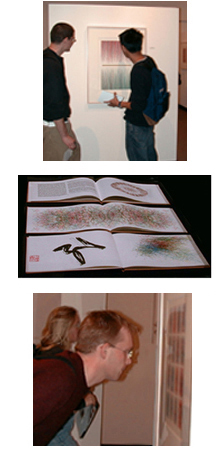![]() Back to
Exhibition | Verostko
Home | Search
Back to
Exhibition | Verostko
Home | Search
| The following page is quoted from the February 2001 issue of ASU's Inside Information Technology. Original format and links preserved for archival value. |
<!-- This page uses CSS, and is best read with JAWS screen reader software using Microsoft Internet Explorer version 5 -->
 |
Front Page
|

Visible Form, Invisible GraceThere is a continuity in the life and work of Roman Verostko that is revealed both in large themes, and in the smallest details. Verostko arrived at the ASU opening of his exhibit of computer-generated art wearing a dark jacket, and a black shirt with a high collar. He joked with those attending that he really "didn't wear it because I used to be a monk." Yet the simplicity of the outfit, and the directness of his comment, were entirely consistent with "Algorithmic Fine Art," now on display at the Computing Commons Gallery. Verostko, a former Benedictine monk, has degrees in philosophy, theology, and art. He has united the multicolored threads of his life in a complex and lucid artistic style rooted in what St. Thomas Aquinas called "claritas," the expression of clarity. He describes himself as part of a group of artists known as algorists. As such, his vision is not focused solely on the ink and paper that form his finished prints. To be sure, there is a marvelous expressiveness in his lines, from the fluidly eloquent Oriental brush strokes in his "Nested Swallow," to the glass-like translucence in the petals of his "Cyberflowers," and the astounding multiplication of forms in "Two Thousand Improvisations." Yet these are just the outer surface of his art. The heart of his work is hidden in the computer programs he writes to produce images which often seem created by hand. The code is reworked by the artist and by the machine for each image, making each one a unique original. An algorithm is a set of actions or procedures, whether mechanical or organic, Verostko said. It may produce a monument like Stonehenge, or the radial pattern of seeds in a sunflower. He gave a simple example by describing a set of instructions to draw a square. First, one must tell the printer to make a line so many inches long, then turn 90 degrees, and repeat the process three times, he said.
Verostko has referred to the code that creates his work as the "score." Nonetheless, it is not a techno-pop effect he is after, but one rich with echoes of the medieval art he loves. In some works, this influence shapes the look of the piece, and in others the connection is more subtle. In "The Illuminated Turing Machine" he places the algorithmic code alongside the flame-like images it produced, in the way that illuminated manuscripts blended images and text. "The Sun Canticles" are based on a poem of St. Francis of Assissi, and "The Visions of Hildegarde" on writings by this nun and mystic. The exhibit also includes a scale model for his 40-foot mural, "Epigenesis, the Growth of Form," created for the University of St. Thomas College of Science and Engineering. Two preliminary sketches for panels of this mural are in the permanent collection of the Computing Commons Gallery, displayed in the third floor reception area of the Computing Commons Building. Always, the signature of his personal style emerges through the machine. His current work reflects the same sensibility he has as a painter, Verostko said. From constructivism, and the Realist Manifesto of Naum Gabo and Antoine Prevsner, he has taken the ideas of kinetic rhythms and the reality of objects. From the "random walk" sensibility of Jackson Pollock's drip paintings, and the cool, jazz-like variations of Piet Mondrian, he developed an appreciation for dynamic equilibrium, for the tension between chaos and order. With over forty years of experience in exploring automatic drawing and line, it is not surprising that he would carry these interests into his programming. What is amazing is that he has managed to express so much spontaneity within the fixed logic of the computer's routine. Here again, one sees the reason for his comparison of his work to music. "The best (algorithms), lean and clean, display a splendid rationality," the artist wrote in a 1994 position statement. "You may never understand why you are moved by hearing Bach's "Musical Offering" — but the score, the procedure for performing the music, is well known and may be studied in every detail." "Algorithmic Fine Art" continues through March 9. Images from the exhibit can be viewed on the artist's Web site, <http://www.verostko.com/shows/tempe/tempe.html>. Additional information about the artist is available at <http://www.penplot.com/>. The Computing Commons Gallery is located on the first floor of the Computing Commons on Orange Street, west of McAllister Avenue. Gallery hours are 10 a.m. to 4 p.m. Monday through Friday. Visitor parking is available in Structure 1 off of Apache Boulevard, or Parking Lot #42 off of Lemon Street. Additional information about the gallery and a schedule of upcoming exhibits can be found online at <http://www.asu.edu/it/spotlight/>. |
![[Inside IT footer image]](footer.gif) |